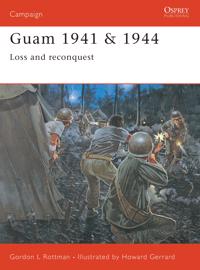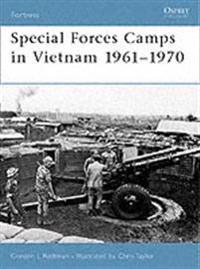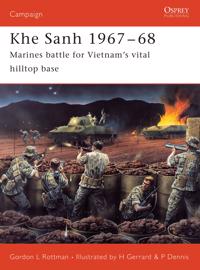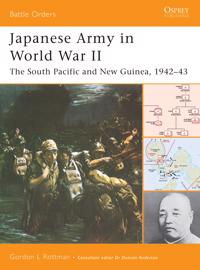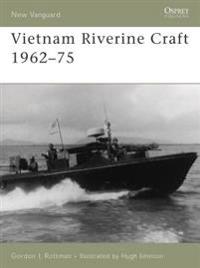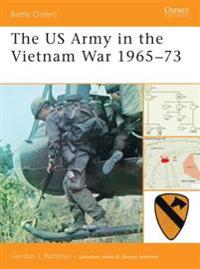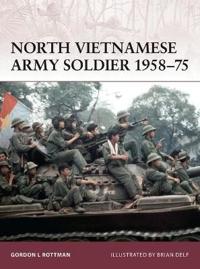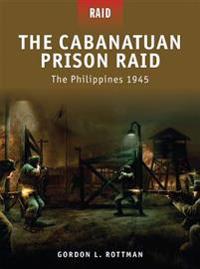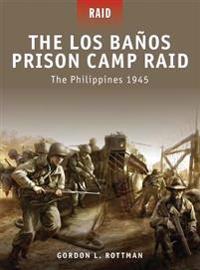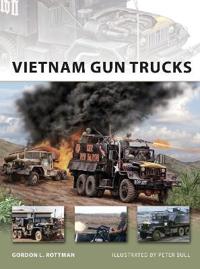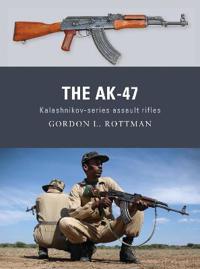German Field Fortifications 1939-45 (Häftad)
avGordon L. Rottman
ISBN: 9781841767611 - UTGIVEN: 200408The German Army of World War II was a highly mobile force. The experience of trench warfare in World War I had done much to shape Germany's blitzkrieg doctrine and concepts of field fortification, and the mobile warfare ethos of World War 2 was designed to avoid the previous war's stalemate. This ti[...]
Guam 1941/1944 (Häftad)
avGordon L. Rottman
ISBN: 9781841768113 - UTGIVEN: 2004-07This volume covers the Japanese seizure of the island of Guam in December 1941 and its American recapture by amphibious assault in July-August 1944. Guam was the first Allied territory lost to the Japanese, making its recapture politically and psychologically important. The American invasion in 1944[...]
Japanese Infantryman, 1937-45 (Häftad)
avGordon L. Rottman
ISBN: 9781841768182 - UTGIVEN: 200508This book examines in detail the Japanese Infantryman who, despite comparisons with the notorious German Waffen SS, was an enigma to Westerners. Brutal in its treatment of prisoners as well as the inhabitants of the areas that it conquered, the Imperial Japanese Army also had exacting standards for [...]
Special Forces Camps in Vietnam, 1961-1970 (Häftad)
avGordon L. Rottman
ISBN: 9781841768397 - UTGIVEN: 200508In 1961 US special forces units began etering remote areas of Vietnam dominated by the Viet Cong. Their task was to organise local defence and strike forces aimed at stopping the enemy from gaining further control of such areas. The Green Berets set up fortified camps akin to forts of the old Amer[...]
The Marshall Islands 1944 (Häftad)
avGordon L. Rottman
ISBN: 9781841768519 - UTGIVEN: 2004-10In November 1943 US forces successfully seized Tarawa and Makin in the first major counteroffensive of the Central Pacific; however, US casualties were heavy. By the end of January 1944. Operation 'Flintlock' - the seizure of the Marshall Islands - was launched: the next stepping-stone towards Japan[...]
Khe Sanh, 1967-68 (Häftad)
avGordon L. Rottman
ISBN: 9781841768632 - UTGIVEN: 200505Khe Sanh was a small village in northwest South Vietnam that sat astride key North Vietnamese infiltration routes. In September 1966 of the Vietnam War (1955-1975), a Marine battalion deployed into the area. Action gradually increased as the NVA attempted to destroy Free World Forces bases, and the [...]
Japanese Army in World War II (Häftad)
avGordon L. Rottman
ISBN: 9781841768700 - UTGIVEN: 2005-12The 1941 Japanese Pacific onslaught saw the defeat of Allied forces on all fronts, with the Philippines, Netherlands East Indies, and Commonwealth possessions falling under their control. During 1942-43, the Japanese consolidated their gains and redeployed forces in an attempt to break the Southern [...]
US Army Infantryman in Vietnam, 1965-73 (Häftad)
avGordon L. Rottman
ISBN: 9781841768878 - UTGIVEN: 200507This study of the US Army infantryman in Vietnam takes the reader through the stages of the soldier's training and acceptance, including his experiences at the Armed Forces Induction Center and his initial introduction to Vietnam's varied conditions of service, whilst detailing developments in weapo[...]
Stryker Combat Vehicle 2002-06 (Häftad)
avGordon L. Rottman
ISBN: 9781841769301 - UTGIVEN: 200607The eight-wheeled (8x8) Stryker combat light armored vehicle was adopted by the US Army in 2002 to provide a comparatively rapidly deployable contingency force with armor protection, tactical mobility and heavy firepower, as well as advanced command, control communications, computer, intelligence, s[...]
Vietnam Riverine Craft 1962-75 (Häftad)
avGordon L. Rottman
ISBN: 9781841769318 - UTGIVEN: 2006-11In 1965 the military situation in the Mekong River Delta of southern Vietnam had deteriorated to such a degree that the decision was made to commit a joint US Army and Navy Mobile Riverine Force to the area. This force was unique in its composition, mission, and the means by which it operated - rive[...]
World War II Airborne Warfare Tactics (Häftad)
avGordon L. Rottman
ISBN: 9781841769530 - UTGIVEN: 200602Airborne warfare - the deployment of large numbers of troops by parachute and glider - reached its zenith during World War II - the only war in which its potential prizes ever justified its great costs, material and human. It required wholly new equipment and tactics; offered a new capability - to i[...]
Viet Cong and Nva Tunnels and Fortifications of the Vietnam War (Häftad)
avGordon L. Rottman
ISBN: 9781846030031 - UTGIVEN: 200608During the Vietnam War, the Viet Cong (VC) main forces and North Vietnamese Army (NVA) were forced to hide weapons and supplies underground and to dig protective shelters to counter massive US firepower. Their field works defended villages, hidden base camps, and fortified complexes, and took the fo[...]
Soviet Field Fortifications 1941-45 (Häftad)
avGordon L. Rottman
ISBN: 9781846031168 - UTGIVEN: 200704From June 1941, the Soviets were forced to undertake large-scale defensive operations in the face of the overwhelming German blitzkrieg assault, operations which ran counter to their preference for highly mobile, offensive warfare. Lessons were quickly learned across a wide variety of terrain and cl[...]
Viet Cong Fighter (Häftad)
avGordon L. Rottman
ISBN: 9781846031267 - UTGIVEN: 200705An enemy in the shadows, the Viet Cong was the military arm of the National Liberation Front, the Communist Party of the Republic of Vietnam. Often working with the North Vietnamese Army, they were a constant factor amid the rice paddies and battlefields throughout the war. Despite fighting an enemy[...]
Vietnam Airmobile Warfare Tactics (Häftad)
avGordon L. Rottman
ISBN: 9781846031366 - UTGIVEN: 200703With its first major use in battle during the Vietnam War, the helicopter ushered in a radically different way of fighting, despite its proven vulnerability to ground fire. Either delivering troops into hostile territory and removing them after the fighting ended, or armed with guns, grenade launche[...]
The US Army in the Vietnam War 1965-73 (Pocket)
avGordon L. Rottman
ISBN: 9781846032394 - UTGIVEN: 200804This book provides detailed information about how US Army units were organized and operated in America's longest war. Special forces veteran Gordon L Rottman examines the different types of infantry battalions and the units that supported them, their training and organization down to platoon level. [...]
North Vietnamese Army Soldier 1958-75 (Pocket)
avGordon L. Rottman
ISBN: 9781846033711 - UTGIVEN: 200902Commonly mistaken for the locally raised Viet Cong, the NVA was an entirely different force, conducting large-scale operations in a conventional war. Despite limited armour, artillery and air support, the NVA were an extremely politicized and professional force with strict control measures and leade[...]
The Cabanatuan Prison Raid (Pocket)
avGordon L. Rottman
ISBN: 9781846033995 - UTGIVEN: 2009-10On 27 January 1945 the 6th Ranger Battalion and the 6th Army Special Reconnaissance Unit (the Alamo Scouts) began the most dangerous and important mission of their careers to rescue 500 American, British and Dutch prisoners-of-war held at a camp near Cabanatuan. This daring plan was fraught with dif[...]
World War II Axis Booby Traps and Sabotage Tactics (Häftad)
avGordon L. Rottman
ISBN: 9781846034503 - UTGIVEN: 200904Booby traps laid by troops in war zones in World War II are largely neglected in histories and memoirs, and rarely examined in detail. Yet for a soldier, the threat of booby traps was hugely significant and the ability to find and disarm them was essential. This is the first comprehensive study of W[...]
The Los Banos Prison Camp Raid (Pocket)
avGordon L. Rottman
ISBN: 9781849080750 - UTGIVEN: 2010-09On the southwest shore of Laguna de Bay in the Philippines stood the Los Banos Internment Camp. Held within were 2,147 starving POWs, surrounded by thousands of Japanese troops. As the desperate battle for Manila raged, only 130 Paratroopers could be spared for the rescue operation. Supported by Ala[...]
The Rocket Propelled Grenade (Pocket)
avGordon L. Rottman
ISBN: 9781849081535 - UTGIVEN: 201009The RPG-series of weapons is the most widely used family of lightweight antitank weapons in the world today. RPGs have been used not only against their intended targets, but against personnel, fortifications, buildings, soft-skin vehicles, watercraft, and aircraft. Lightweight, relatively compact, e[...]
Vietnam Gun Trucks (Häftad)
avGordon L. Rottman
ISBN: 9781849083553 - UTGIVEN: 201109"Vietnam Gun Trucks".
The AK-47 (Pocket)
avGordon L. Rottman, Johnny Shumate, Alan Gilliland
ISBN: 9781849084611 - UTGIVEN: 201104The Kalashnikov AK-47 is the most ubiquitous assault rifle in the world, with more AK-47s and its variants in use than any other individual small arm. Created by Senior Sergeant Mikhail Kalashnikov, and first adopted by the USSR soon after World War II, its production continues to this day, with an [...]
Tunnel Rat in Vietnam (Häftad)
avGordon L. Rottman
ISBN: 9781849087834 - UTGIVEN: 201202"Tunnel Rat in Vietnam".


